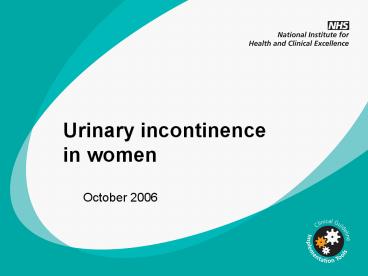Urinary incontinence - PowerPoint PPT Presentation
1 / 22
Title:
Urinary incontinence
Description:
smoking, diet and obesity. cognitive or functional impairment. Treatment ... previous surgery has been done for stress UI or anterior compartment prolapse ... – PowerPoint PPT presentation
Number of Views:311
Avg rating:3.0/5.0
Title: Urinary incontinence
1
Urinary incontinence in women
October 2006
2
Changing clinical practice
- NICE guidelines are based on the best available
evidence - The Department of Health asks NHS organisations
to work towards implementing guidelines - Compliance will be monitored by the Healthcare
Commission
3
Need for this guideline
- Urinary incontinence (UI) commonly affects women
of all ages - It can seriously affect physical, psychological
and social wellbeing - The impact on families and carers may be profound
- Estimated current cost to the NHS is 233 million
annually
4
UI is common but hidden
- Estimated 4 million women over 40 years regularly
incontinent in UK
5
Urinary incontinence
- Defined as involuntary urinary leakage
- May occur as a result of
- functional abnormalities of the lower urinary
tract - other illnesses
- These tend to cause leakage in different
situations
6
How UI presents
Classification Symptoms
Stress UI on effort, exertion, or sneezing or coughing
Mixed UI with urgency and exertion, effort, sneezing or coughing
Urge UI or overactive bladder syndrome (OAB) with or immediately preceded by a sensation of urgent need to urinate, with or without frequency
7
Spot the risk factors
- Associations and possible risk factors include
- age
- obstetric factors such as pregnancy and parity
- menopause and hysterectomy
- lower urinary tract symptoms
- family history and genetics
- smoking, diet and obesity
- cognitive or functional impairment
8
Treatment pathway
9
What the guideline covers
- Initial assessment and investigation
- Conservative management, including? bladder
training ? supervised pelvic floor muscle
training ? pharmacological therapy - Multi-channel cystometry
- Surgical treatment options
- Competencies for surgeons performing operations
10
Assess and investigate
- Assess using
- bladder diaries
- urine dipstick test
- post void residual volume
- Consider
- fluid intake
- caffeine consumption
- weight loss
- Categorise and treat according to type of UI
11
Support initial assessment
- Raise awareness of NICE recommendations and
develop training opportunities to focus on key
aspects - Review and update local referral and care
pathways - Use local multidisciplinary and specialist teams,
such as integrated continence services - Use tools and questionnaires to support symptom
scoring and quality of life assessment
12
Manage conservatively
Stress UI MixedUI Urge UI or OAB First pregnancy
Pelvic floor muscle training
Bladder training
Antimuscarinic treatment
13
Offer training and drugs
- Pelvic floor muscle training
- Eight contractions, three times a day, 3 months
minimum - Bladder training
- 6 weeks minimum
- Antimuscarinic drugs
- Immediate-release oxybutynin as first choice
Offer support and advice for side effects - Multi-channel cystometry, ambulatory urodynamics
or videourodynamics are not recommended before
starting conservative treatment
14
Support conservative choices
- Review who is offering supervised pelvic floor
muscle training and bladder training locally - Update prescribing policies and formularies in
line with the guideline - Underline the importance of support and advice
about side effects when prescribing medication
for UI
15
Use cystometry if appropriate
- Multi-channel filling and voiding cystometry is
recommended before surgery if - detrusor overactivity suspected
- previous surgery has been done for stress UI or
anterior compartment prolapse - symptoms suggest voiding dysfunction
- Also consider ambulatory urodynamics or
videourodynamics
16
Offer surgical management
- If conservative treatments have failed for
- overactive bladder with or without urge UI offer
- - sacral nerve stimulation
- stress UI offer
- - retropubic mid-urethral procedures
- alternatively colposuspension or rectus fascial
sling
17
Skills for surgeons
- Surgeons undertaking surgery should
- receive appropriate training in the management of
UI and associated disorders, or - work within a multidisciplinary team with this
training - regularly carry out surgery for UI in women
18
Support surgical options
- Review local access, consider use of regional
services - Formally assess current practice for surgeons
- Maintain skills with a minimum annual workload
- 20 cases per year per primary procedure - Nominate a clinical lead within each surgical
unit - Encourage surgeons to submit outcomes to national
registries
19
Treatment pathway
20
Target resources
Recommendations with significant resource impact Annual cost 000s
Urodynamic investigations before conservative treatment -3,019
Urodynamic investigations before primary surgery -321
Sacral nerve stimulation 307
Total net saving of implementing the UI guideline -3,033
21
Access tools online
- Costing tools
- costing report
- costing template
- Audit criteria
- Implementation advice
- Available from www.nice.org.uk/CG040
22
Access the guideline online
- Quick reference guide a summary
www.nice.org.uk/CG040quickrefguide - NICE guideline all of the recommendations
www.nice.org.uk/CG040niceguideline - Full guideline all of the evidence and
rationale www.nice.org.uk/CG040fullguideline - Understanding NICE guidance a plain English
version www.nice.org.uk/CG040publicinfo































